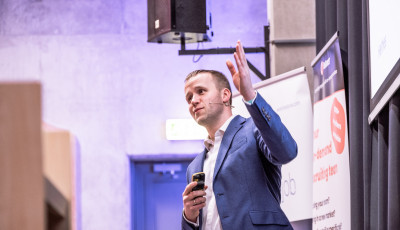By its very nature, software development is a people business. Helmes’s business model sees us put together world-class development teams: we work with people who are experts on digital innovation. Meelis Lang, our Chief Innovation Officer, shares how Helmes Way autonomous teams create more value for our customers.
Helmes Way autonomous software development teams are incredibly efficient if compared to other software development outsourcing models. We can guarantee 150% efficiency both in delivery and ownership, but in many cases, we achieve much more.
What makes this specific team management model so successful? In a nutshell: autonomy in our teams is shaped by a framework within which values form the foundations and indicators of its boundary lines. On the one hand, our teams enjoy a great deal of autonomy, with each team leader like the head of their own small company. On the other hand, taking responsibility is guaranteed.
Responsible autonomy has a hockey-stick effect
We’ve been developing Helmes as an autonomy-based organisation for more than 15 years. During the global financial crisis in 2008 we saw an opportunity to build something new and better. Though it’s common practice in the sector, financial success that comes at the expense of clients or employees is unsustainable. There must be a human dimension, not just a financial one: you have to genuinely care about people.
Do managers care about the people working for them?
Do team members care about one another or the success of their clients?
In our model, we’re guided by the logic of the three-legged stool, where one leg is people, another leg is customer satisfaction, and the third leg is financial results. You can’t implement this model if your organisation’s values aren’t in place – otherwise, the legs will soon start wobbling. In the first two years of adopting our new approach, many of our previous managers left the company. This bloodletting was followed by a hockey-stick effect which saw the model truly blossom: we achieved growth and reached stability in every indicator, allowing autonomy to shine.
Any time an indicator strays from where it should be, it takes time to sort it out and make the changes you need to get it back in place. With us, that period is usually around six months.
The first question you must ask when a problem crops up is whether you have a plan with which to solve it. If the situation doesn’t improve in a reasonable amount of time, autonomy’s ability to work is at risk. The reason for this is often a lack of critical competence, which must thereafter be given more central support.
Shared values as a foundation
Years of experimenting with autonomy have made it clear to us that to guarantee its long-term success you need strong foundations and smart boundaries to work within so that you can keep your balance and not tumble over the edge. Shared values form a strong foundation, while uniform indicators provide the protective barriers you need. Here it’s important to take cultural differences into account and to accept that flexibility is needed, because what motivates people in Estonia won’t necessarily have the same effect in, say, India.
People are used to rules, but that’s not what Helmes cultivates.
A flourishing business culture based on values is much more effective than any set of rules.
The key to success in a people-centric business is choosing the right people to begin with. The person with the most leverage is the team leader, who enjoys financial freedom and the opportunity to invest in people and grow their team. If the choice of team leaders is right and autonomy enables them to come up with the best way of achieving results, all the prerequisites are in place for the company to be successful.
Strength-based leadership is vital
To be a successful team leader, the leader must know themselves and their team members. A good leader of people is aware of their team’s strengths or finds a way to learn what they are. It’s often the case that specialists aren’t taught or allowed to look any further than what they themselves have to do. Even their job description and title can restrict their ability to act.
This raises the question of how you can remain useful to your employer when roles become blurred. Strength-based leadership looks at the person’s strength profile, taking into consideration everything that drives someone and generates value, even if it doesn’t necessarily align with their role and specialization. If people have different roles in different teams, strength-based leadership becomes more complex but not impossible. As such, you can create added value in the grand scheme of things: people themselves start looking for ways of overcoming their mental obstacles about not being useful if they’re not doing exactly what their job description says they should be doing.
If you want autonomy, you need a manager who’s not bogged down in a trench of their own making. There has to be trust and a shared understanding of the company’s aims.
Get in touch




